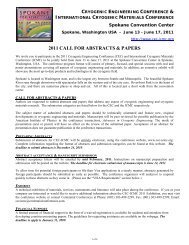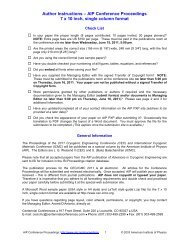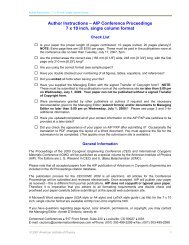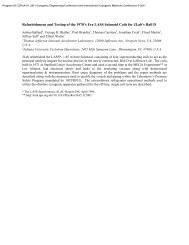CEC Abstracts in PDF format (as of 7/3/07) - CEC-ICMC 2013
CEC Abstracts in PDF format (as of 7/3/07) - CEC-ICMC 2013
CEC Abstracts in PDF format (as of 7/3/07) - CEC-ICMC 2013
You also want an ePaper? Increase the reach of your titles
YUMPU automatically turns print PDFs into web optimized ePapers that Google loves.
<strong>CEC</strong> 20<strong>07</strong> - <strong>Abstracts</strong><br />
C3-B-02 Development <strong>of</strong> a Compressor for a M<strong>in</strong>iature<br />
Pulse Tube Cryocooler <strong>of</strong> 2.5 W at 65 K for<br />
Telecommunication Applications<br />
N Matsumoto, Y Y<strong>as</strong>ukawa, K Ohshima, T Takeuchi,<br />
T Matsushita, Y Mizoguchi, Fuji Electric Systems Co.,<br />
Ltd.<br />
Fuji Electric group h<strong>as</strong> established ma<strong>in</strong> technologies for high<br />
reliability <strong>in</strong> some stirl<strong>in</strong>g cryocoolers for space satellite systems. We<br />
also have developed and started sell<strong>in</strong>g a m<strong>in</strong>iature pulse tube<br />
cryocooler from 2 W to 3 W at 70 K with 100 W electric power <strong>in</strong>put<br />
for any commercial applications. In development <strong>of</strong> a new<br />
compressor, we <strong>in</strong>troduce a mov<strong>in</strong>g magnet to a driv<strong>in</strong>g system <strong>in</strong><br />
order to achieve moreover compactness and higher efficiency, not a<br />
mov<strong>in</strong>g coil that is a conventional system with about 70% efficiency.<br />
And an Expander is adopted a coaxial pulse tube for compactness.<br />
This development is for cool<strong>in</strong>g a high temperature superconductive<br />
device <strong>in</strong> a wireless telecommunication system. The compressor<br />
requires total compression work <strong>of</strong> 75 W with 90% efficiency and<br />
longer than 50,000 hour.<br />
So far, the primary tests that a part <strong>of</strong> a mov<strong>in</strong>g magnet l<strong>in</strong>er motor<br />
and a coaxial pulse tube have f<strong>in</strong>ished. As next ph<strong>as</strong>e, we have made a<br />
first stage prototype compressor used by the new l<strong>in</strong>er motor, and then<br />
we have tested the new mach<strong>in</strong>e. This paper ma<strong>in</strong>ly describes the test<br />
results <strong>of</strong> the compressor.<br />
A Japanese government <strong>in</strong>stitution, the M<strong>in</strong>istry <strong>of</strong> Public<br />
Management, Home affairs, Posts and Telecommunications<br />
C3-B-03 High Frequency Nonmagnetic and Nonmetallic<br />
Pulse Tube Cryocooler for 80K<br />
Y.Q. Xun, L.W. Yang, J.H. Cai, J.T. Liang, Y. Zhou,<br />
Technical Institute <strong>of</strong> Physics and Chemistry <strong>of</strong> CAS.<br />
Many cryogenic apparatus, such <strong>as</strong> Superconduct<strong>in</strong>g Quantum<br />
Interference Devices (SQUIDs), are quite strict with the cold source<br />
for their sensitivity to the mechanical and magnetic vibrations. The<br />
high frequency pulse tube cryocooler (PTC) h<strong>as</strong> considerable system<br />
advantages due to the reduction <strong>of</strong> <strong>in</strong>duced electromagnetic<br />
disturbance and simple mechanism for hav<strong>in</strong>g no mov<strong>in</strong>g part <strong>in</strong> the<br />
cold head. By us<strong>in</strong>g nonmagnetic and nonmetallic materials for ma<strong>in</strong><br />
components, we are develop<strong>in</strong>g a high Frequency coaxial nonmetallic<br />
and non-magnetic PTC system with lower vibrations and<br />
electromagnetic <strong>in</strong>terferences to supply the low-noise cool<strong>in</strong>g for<br />
highly magnetic flux sensitive high-Tc superconductor<strong>in</strong>g electronics<br />
<strong>in</strong>clud<strong>in</strong>g high-Tc SQUIDs. A l<strong>in</strong>er compressor is used to drive this<br />
version <strong>of</strong> PTC. With an <strong>in</strong>put electric power <strong>of</strong> 35W and 42Hz<br />
operation frequency, this PTC h<strong>as</strong> achieved a no-load temperature <strong>of</strong><br />
76.9K and provides a cool<strong>in</strong>g power <strong>of</strong> 0.1W at 82K.<br />
Research supported by National Natural Science Foundation <strong>of</strong><br />
Ch<strong>in</strong>a. (Grant No.50476086)<br />
C3-B-04 Experimental Investigation on Multi-byp<strong>as</strong>s and<br />
Fixed Ph<strong>as</strong>e-shifter Comparison <strong>in</strong> S<strong>in</strong>gle-stage High<br />
Frequency Pulse Tube Cryocooler<br />
X.F. Hou, L.W. Yang, J.T. Liang, Y. Zhou, Technical<br />
Institute <strong>of</strong> Physics and Chemistry <strong>of</strong> CAS.<br />
A below 40K s<strong>in</strong>gle-stage high-frequency pulse tube cryocooler(PTC)<br />
is <strong>in</strong>troduced <strong>in</strong> this paper. At present, the lowest temperature <strong>of</strong><br />
34.22K with <strong>in</strong>put power <strong>of</strong> 222W is reached. Four fixed ph<strong>as</strong>e shifter<br />
<strong>in</strong>clud<strong>in</strong>g <strong>in</strong>ertance tube, <strong>in</strong>ertance tube plus double <strong>in</strong>let, <strong>in</strong>ertance<br />
tube plus multi-byp<strong>as</strong>s and <strong>in</strong>ertance tube plus double <strong>in</strong>let plus multibyp<strong>as</strong>s<br />
are compared by experiments. Experiments show that<br />
<strong>in</strong>ertance tube plus double <strong>in</strong>let plus multi-byp<strong>as</strong>s is a best choice to<br />
apply very low temperature and <strong>in</strong>ertance tube is a good choice to<br />
apply high temperature and large cool<strong>in</strong>g power <strong>in</strong> s<strong>in</strong>gle-stage high<br />
frequency PTC. And the experiments also show that multi-byp<strong>as</strong>s plus<br />
nozzle can decre<strong>as</strong>e the DC flow <strong>in</strong> PTC and <strong>in</strong>cre<strong>as</strong>e the performance<br />
<strong>of</strong> PTC.<br />
C3-B-05 Experimental demonstration <strong>of</strong> a Novel Heat<br />
Exchange Loop Used for Oscillat<strong>in</strong>g Flow Systems<br />
B. Gao, Technical Inst. <strong>of</strong> Physics and Chemistry,<br />
CAS; Graduate University <strong>of</strong> Ch<strong>in</strong>ese Academy <strong>of</strong><br />
Sciences; Z.H. Wu, Technical Institute <strong>of</strong> Physics and<br />
Chemistry, CAS; W. Dai, E.C. Luo, Technical Institute<br />
<strong>of</strong> Physics and Chemistry,CAS.<br />
This paper proposed a non-resonant self-circulat<strong>in</strong>g heat exchanger<br />
which uses a pair <strong>of</strong> s<strong>in</strong>gle-direction valves to transform oscillat<strong>in</strong>g<br />
flow <strong>in</strong>to steady flow that allows the oscillat<strong>in</strong>g flow system’s own<br />
work<strong>in</strong>g g<strong>as</strong> to go through a physically remote high-temperature or<br />
cold-temperature heat source. Unlike traditional oscillat<strong>in</strong>g flow heat<br />
exchangers, the length <strong>of</strong> non-resonant self-circulat<strong>in</strong>g heat exchanger<br />
is not limited by the peak-to-peak displacement. In addition, it is also<br />
different from the resonant self-circulat<strong>in</strong>g heat exchanger that needs<br />
a specific resonant length [G.Swift and S. Backhaus, A resonant, selfpumped,<br />
circulat<strong>in</strong>g thermoacoustic heat exchanger," Journal <strong>of</strong> the<br />
Acoustical Society <strong>of</strong> America 116, 2923-2938 (2004)]. This<br />
<strong>in</strong>vention may lead to e<strong>as</strong>y design and fabrication <strong>of</strong> heat exchangers<br />
for oscillat<strong>in</strong>g-flow refrigeration system with large capacity. To verify<br />
this idea, we have built an experimental system by <strong>in</strong>corporat<strong>in</strong>g such<br />
a heat exchanger <strong>in</strong>to a pulse-tube type <strong>of</strong> Stirl<strong>in</strong>g refrigerator.<br />
Me<strong>as</strong>urements <strong>of</strong> heat transfer <strong>of</strong> the heat exchanger under different<br />
operat<strong>in</strong>g conditions <strong>in</strong>clud<strong>in</strong>g pressure ratio, mean pressure, and<br />
operat<strong>in</strong>g frequency, etc. have been made. Our experiments have<br />
demonstrated its fe<strong>as</strong>ibility and great flexibility for practical<br />
applications.<br />
This work w<strong>as</strong> supported by the Natural Sciences Foundation <strong>of</strong><br />
Ch<strong>in</strong>a(Grant. No.50625620).<br />
C3-B-06 A low cost pressure wave generator us<strong>in</strong>g<br />
diaphragms<br />
A.J. Caughley, Industrial Research Ltd; D. Haywood,<br />
Industrial Reserach Ltd; C. Wang, Cryomech.<br />
The high cost <strong>of</strong> Pressure Wave Generators (PWGs) is a major barrier<br />
to the more widespread use <strong>of</strong> high-efficiency pulse tube and Stirl<strong>in</strong>g<br />
cryocoolers. This paper describes the development and test<strong>in</strong>g <strong>of</strong> a<br />
low-cost <strong>in</strong>dustrial-style PWG which employs metal diaphragms. The<br />
use <strong>of</strong> diaphragms removes the need for rubb<strong>in</strong>g or clearance seals,<br />
and elim<strong>in</strong>ates contam<strong>in</strong>ation problems by hermetically separat<strong>in</strong>g the<br />
g<strong>as</strong> circuit and the lubricated driv<strong>in</strong>g mechanism. The diaphragms<br />
also allow a conventional low-cost electric motor to be used <strong>as</strong> the<br />
power <strong>in</strong>put device for the PWG, via a novel high-efficiency<br />
k<strong>in</strong>ematic l<strong>in</strong>kage. A first prototype <strong>of</strong> the diaphragm PWG produced<br />
approximately 3.3 kW <strong>of</strong> PV power with a me<strong>as</strong>ured electro-acoustic<br />
efficiency <strong>of</strong> 69%. Accelerated test<strong>in</strong>g predicts a diaphragm life time<br />
<strong>in</strong> excess <strong>of</strong> 40,000 hours. An additional advantage <strong>of</strong> the use <strong>of</strong><br />
diaphragms is the ability to directly cool the g<strong>as</strong> <strong>in</strong> the compression<br />
space. This elim<strong>in</strong>ates or significantly reduces the requirement for an<br />
aftercooler, and further decre<strong>as</strong>es the cost <strong>of</strong> the whole cryocooler<br />
system. A pulse tube cryocooler h<strong>as</strong> been successfully run at<br />
Industrial Research Ltd to 59K with the diaphragm PWG and no<br />
aftercooler. Another pulse tube cryocooler with the diaphragm PWG<br />
is undergo<strong>in</strong>g development at Cryomech, the results <strong>of</strong> which will be<br />
given <strong>in</strong> another presentation.<br />
This programme w<strong>as</strong> supported by the Foundation for Research,<br />
Science and Techology, New Zealand.<br />
Page 36 <strong>of</strong> 53






